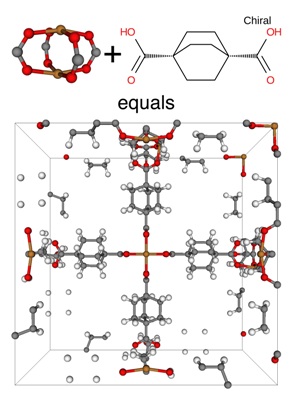Dec 22 2014
Cars which use natural gas as an energy source are considered eco-friendly and efficient but obtaining the gas in order to keep them running can be problematic. Rice University researchers have now carried out a study that which could solve this problem.
 These examples of metal organic frameworks, which may be suitable for natural gas storage, were discovered through a computer algorithm developed at Rice University.
These examples of metal organic frameworks, which may be suitable for natural gas storage, were discovered through a computer algorithm developed at Rice University.
The Department of Energy (DOE) supports scientists in the quest to find new materials which can store compressed natural gas at room temperature and at low pressure. Some of the materials studied are cage-like synthetic macromolecules, known as metal organic frameworks (MOFs).
MOFs are nanoscale metal ion or cluster compounds known as organic binding linkers or ligands and secondary building units (SBUs). These linkers bind the SBUs in a spongy network, which can store and capture methane molecules in a pressure tank. On relieving of pressure, the methane is released by the network for use.
As there are tens of thousands of MOFs, it is challenging to synthesize them to be tested. Researchers use computers for modeling of candidates having the right qualities.
Michael Deem, a Rice bioengineer, used a custom algorithm to not just design novel MOF configurations, which can store natural gas with an increased deliverable capacity, however he was also able to synthesize them from commercial precursor molecules. The algorithm is also capable of tracking the routes to synthesis.
Deem and his team of Rice researchers, the University of California-Berkeley and Lawrence Berkeley National Laboratory reported their results in the Journal of Physical chemistry, American Chemical Society this month.
MOFs show potential for applications such as drug sensing, delivery, catalysis and purification, but methane storage for transportation is high in the wish list on the DOE. Deem said “MOFs are being commercialized for methane storage in vehicles now.”
The benefits of using MOF as a storage medium are numerous, one of which is its higher capacity when compared to high-pressure, heavy cylinders used currently. According to the Rice Study, 48 MOFs were found that were superior to the ones presently available, which is a compound called MOF-5, by around 8%.
The program complied with standard DOE conditions, which an ideal MOF will store methane at 65 bar and release it at 5.8 bar, all at 298°K.
The pressure is considerably less when compared to standard CNG tanks, and the temperature is much higher than liquid natural gas tanks, which must be cooled to -260° F.
Lower pressures mean tanks can be lighter and made to fit cars better, Deem said. They may also enable customers to store from household gas supply lines. The algorithm from the Deem group was taken from a previous project for the identification of zeolites.
Monte Carlo calculations were run on almost 57,000 precursor molecules by the researchers modifying them through synthetic chemistry reactions through the computer to determine which would help in creating MOFs with the highest deliverable capacity. Deliverable capacity may be defined as the amount of fuel, which can be stored and released for use. “Our work differs from previous efforts because we’re searching the space of possible MOF linkers specifically for this deliverable capacity,” Deem said.
The researchers anticipate that they can commence real-world testing of the best MOF models. “We’re very keen to work with experimental groups, and happy to collaborate,” Deem said. “We have joint projects underway, so we hope some of these predicted materials will be synthesized very soon.”
The lead author of the paper is Yi Bao, a graduate student in Deem’s lab at Rice’s BioScience Research Collaborative. Co-authors are Richard Martin and Maciej Haranczyk of the Lawrence Berkeley National Laboratory and Cory Simon and Berend Smit of the University of California-Berkeley. Deem is chair of Rice’s Department of Bioengineering and the John W. Cox Professor of Biochemical and Genetic Engineering.
The research was supported by the DOE Office of Basic Energy Sciences, Division of Chemical Sciences, Geosciences and Biosciences, supported the research. The researchers used DAVinCi supercomputer funded by the National Science Foundation and administered by Rice’s Ken Kennedy Institute for Information Technology.